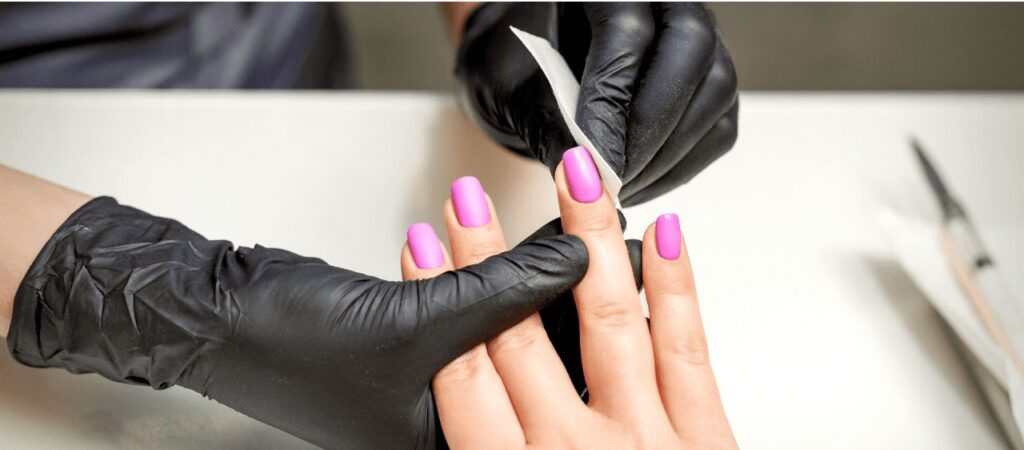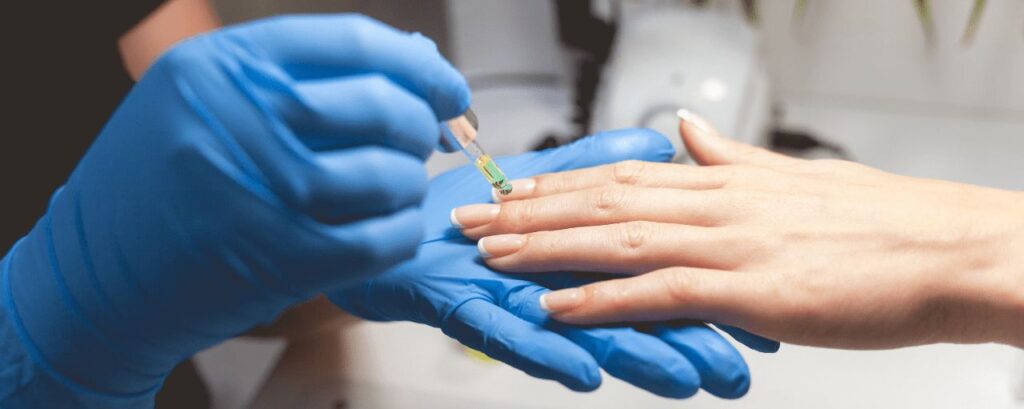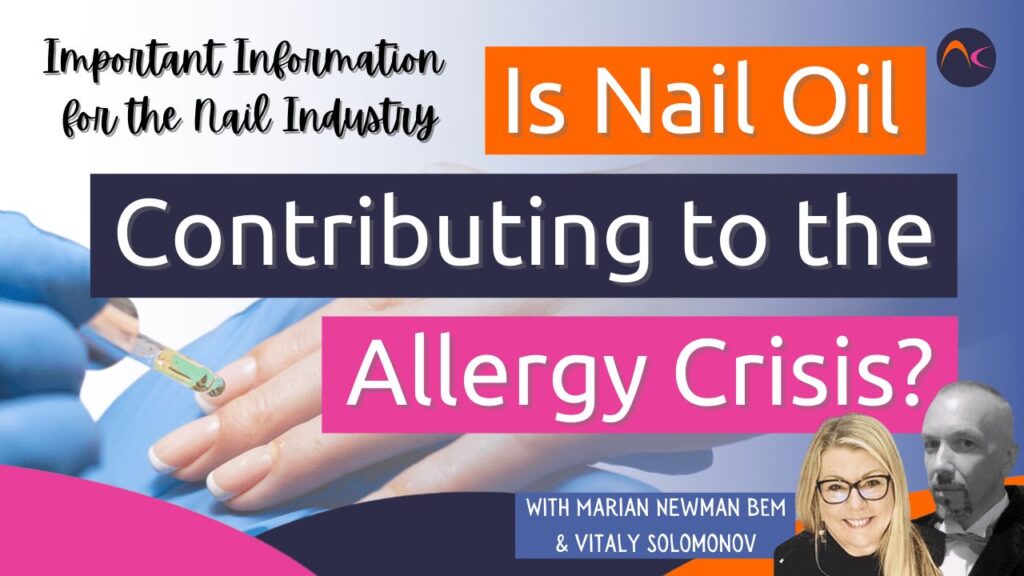We know about allergies. We know about sub-standard nail products. But this is very important information for the Nail Industry.
Uma pesquisa muito recente que acaba de ser publicada (agosto de 2021 no The Journal of Allergy and Clinical Immunology) mostrou outro problema do qual DEVEMOS estar cientes e prestar atenção. Há muitas informações sobre skin moisturisers in beauty products, but this article is just concerned with how us, as nail professionals, are affected.
Meu amigo e colega, Vitaly Solomonov, dermatologist and expert for NailKnowledge has also provided some more science and the references to support this information – Azul destacado.
Há três estudos que foram publicados e outros estão em andamento.
What has been shown is that many ‘natural oils’ are harmful to the skin and disrupt the skin barrier.
The most relevant cause for concern in nail services is regarding UV gel top coats. Both traditional and ‘tack-free’.

EVERY nail professional, surely, must know that the sticky layer remaining after curing is unreacted product? But how many take the time and have the understanding that this must NOT touch the skin during the final cleansing?
Há dois métodos para fazer isso com segurança:
- Soak a pad in the recommended cleanser (which is usually an alcohol such as IPA). Start at the little finger and wipe the nail from base to free edge and NOT backwards nor side to side. Move onto the larger nails so the product on the pad is not touching the skin.
- Ainda mais seguro é usar uma nova almofada embebida para cada unha.
Quantas vezes você vê essa almofada sendo esfregada em toda a unha e, portanto, na pele, e a mesma área da almofada sendo usada para cada unha? Isso está depositando produto não curado em toda a pele ao redor!
Top coats sem aderência: eles podem não parecer pegajosos e alguns os usam para economizar tempo, pois não fazem a etapa de limpeza final. MAS eles ainda têm algum produto não curado na superfície. Eles DEVEM ser limpos!
Qual é a etapa mais comum depois disso? Óleo! Massageie-o em toda a unha e na pele.

Então, aqui está o problema! O produto não curado está sobre a pele, o óleo é aplicado.
What the studies have shown is that the oil can act as ‘penetration enhancers’. This means that they are encouraging the penetration of allergens (placed onto the skin during the service) directly into the living cells of the skin!
De Vitaly:
Em primeiro lugar, gostaria de resumir os resultados dos estudos recentes que Marian mencionou acima. Esses trabalhos trouxeram notícias realmente inovadoras e podem ter um impacto em vários setores, inclusive no setor de unhas, sob vários pontos de vista. Aqui está a conclusão mais importante, entre outras, que podemos tirar dos estudos:
It has been shown that the moisturisers (lotions and oils) that are widely used in baby skin care led to development of food allergy, atopic dermatitis and even asthma in the future life of an infant if they used frequently.
This sounds too scary, doesn’t it? However, let’s get started to sort things out to understand what is going on.
The phenomenon that mentioned in the first notion occurs because oils, especially those natural oils like olive, sunflower and many others may partly disrupt the skin barriers and potentiate the permeation of many compounds including allergens. The oils or lipid compounds can dissolve the allergenic substances and make them available to the immune cells in our skin. For instance, the trace neglectable amounts of milk shakes or mixtures for infants can be left on a baby’s skin after the contact with parents’ hands. Then, when we apply the moisturiser, its lipid components encourage the penetration of them into the baby’s skin. If the immune cells recognize the food components to be allergic, the reaction begins, and allergy develops immediately or many years after when a kid becomes an adult. That is why, one of the authors openly declare the following motto: “Olive oil is for food, not for skin care”, despite the current fashion for so called ‘natural’ or ‘organic’ products.
The data can be logically applied for our salon services because a nail technician often deal with potentially allergic substances such as uncured gels or ‘tacky residue’. Thus, the tacky residue being mixed with the oily components of the cosmetic products and easily penetrate the skin. It is important to note, that the components of nail products are not allergens itself. True allergens are always proteins. The components of UV gels, nail polishes or acrylics are not proteins. Now you can ask – Why are they considered to be potential allergens then? The key word here is ‘potential’. These substances that can be potentially harmful for your skin have their own name – let me introduce them – haptens. Haptens are substances of different chemical classes. They usually have a small molecular mass and can penetrate the skin barriers. They are not considered as allergens unless they come into reaction with our own proteins that are found in our skin. In this case they form the compound that become an allergen for us. Most of haptens are ‘oil loving’ molecules, which means that they can be dissolved in oils, which in turn helps them to penetrate the skin where they meet the lipid bilayers of our own Stratum Corneum and mix with them too.
Good news is that our skin is not a static structure or just a container that contains some mixtures. It has its structure, and the structure defines the health of our skin. The skin’s major responsibility is to protect us, and it means that all the skin structures do their best to prevent the permeation of almost all the outer substances, even those that are considered as ‘good for us’. Moreover, the human’s skin is ever changing organ and it strives to free our body from harmful or unnecessary substances by pushing out old layers and cells. The latter are just removed from the surface of the skin. It helps to ‘clean up’ the space.
On the other hand, we have to learn that cosmetic products may have an impact on very important structures in the stratum corneum. The most important part of those structures is lipids/water ratio (and water retaining substances, which are known as the natural moisturising factor). These two components create the optimal consistency of our skin, where the essential lipids are a key factor since they create the compact barrier. When it becomes too thick the skin is getting scaly and dry. When those lipids become too liquid, the skin becomes too prone to inflammation due to the partially disrupted barriers.
O que é importante para nós e para nosso trabalho?
1) The frequent use of moisturisers can be harmful. Then the next question – what is ‘frequent’ use? The answer to the question – use your moisturiser 1-2 times a day. If you have symptoms of xerotic skin, use the special lotions and as professionals don’t blindly follow the marketing claims. Read the list of ingredients.
2) Oils. It is obvious, that we use the cuticle oils to prevent water evaporation from the area that we worked on, because some procedures (especially those that are well known as harmful – abrasions, solvents, peelings, etc. lead to water loss and dryness). Dryness is a first signal of disrupted skin barriers and the first step of possible skin inflammation). Always use the cuticle oils after you wash your hands with a soap or liquid soap.
3) Quando o serviço estiver concluído e o próximo conjunto perfeito de lindas unhas estiver criado, peça à cliente que lave as mãos com sabonete antes de aplicar uma loção, um creme ou qualquer outro hidratante para evitar um possível surto de alergia.
4) If you work with a ‘tacky layer’, thoroughly remove it out first with acetone or isopropyl alcohol and then always wash with a soap before your next step in service.
5) Never touch skin with a product and keep your brush and other utensils clean even if you work in gloves.
6) Se você achar que seu hidratante regular causa ressecamento, troque-o por uma fórmula e ingredientes mais avançados.
7) Avoid products with a huge load of essential oils, fragrances, and colorants – it will help to avoid allergy outbreak.
8) Avoid products that are advertised as ‘natural’ – that doesn’t mean they are safer. Often, most of them are considered as more allergenic, especially for the vulnerable skin types. Studies confirm this notion.
Mais uma causa adicional de surtos de alergia em nosso setor!
Oil is a ‘non-negotiable’ addition to every nail e atendimento domiciliar, portanto, essa etapa não pode ser evitada. Mas acrescentar um problema a uma possível alergia é 100% evitável!
Entenda seus produtos, entenda a ciência. Trabalhe com segurança e minimize qualquer dano que possa estar causando aos seus clientes e a você mesmo!


